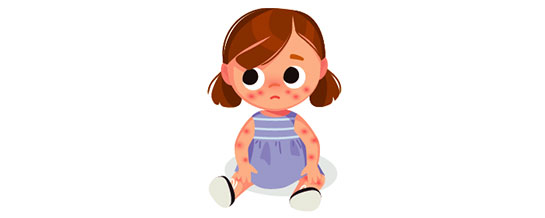How to Care for Your Child with a Viral Skin Rash
This leaflet will provide you with information about viral skin rash causes, symptoms, diagnosis, treatment and home care advice.

Rashes are very common in children and babies. Most children and babies get rash at some point during childhood. It is common for the rash to spread to most or all of the body before it goes away in few days to weeks.
What causes rashes?
The most common cause is:
- Viral infections, which will go away on their own.
- Other causes include:
- Irritation from soup products or chemical
- Heat
- Allergy
- Bacterial Infection
What are the symptoms of a viral rash?
Some viruses cause rashes that look quite unique. Rashes can present with different appearances:
- Red flat areas
- Raised bumps
- Blisters
- Welts
- Or any combination of these.
Most rashes are mild and do not cause your child any distress, although some rashes can cause a lot of itching.
How is a viral rash diagnosed?
- The doctor will ask few questions about your child’s health and examine your child.
- Your child’s doctor will decide if further investigation or blood tests are required.
- During the assessment your child’s doctor would be able to differentiate between serious rashes and simple viral rash
- It is not important to know which virus is causing the rash. Most rashes will get better on their own.
How is a viral rash treated?
- Medicines are mostly given to reduce symptoms and to control fever
- Antibiotics do not work on viruses and are not given to children with rashes caused by viral infections.
- Do not give any cough or cold medicines to children younger than 12 years. These medicines can cause serious side effects.
- If your doctor advises to give medicine, you can give
- Paracetamol (any brand) or Ibuprofen (any brand)
- Some medicines can help relieve the itch only if your child's rash is itchy,
- Follow the instruction on the medicine package for the correct dose for your child
- Do not give your child Aspirin as this can cause serious side effects
Home care advice
To make your child feel more comfortable during viral illness:
- Give your child plenty of liquids. Warm liquids can be soothing.
- To help with a runny or stuffy nose:
- Run a cool-mist humidifier. Clean after each use.
- For babies: Put a few drops of saline (saltwater) into the nose, then gently suck the mucus out with a bulb syringe.
- For older kids: Give 2 sprays of saline nose spray 3 times a day for 4 days.
- If the skin under your child's nose is sore, put petroleum jelly on it.
If the rash is itchy:
- Remind your child not to scratch the skin because this might make the rash worse.
- Keep your child's nails short and smooth.
- Gently put a cool, wet washcloth on your child's rash.
- Keep your child cool. Heat can make a rash itch more.
- Use mild soap when bathing and rinse well. Pat the skin dry (don't rub).
- When doing your child's laundry, use fragrance-free products (detergent, fabric softener, and dryer sheets).
How to help prevent the spread of viruses?
All family members should:
- Wash hands properly using soap and water for at least 20 seconds, rinse and dry thoroughly. This is especially important after coughing or sneezing, and before eating or preparing food.
- If soap and water are not available, use hand sanitizer with at least 60% alcohol
- Clean tabletops, doorknobs and other hard surfaces with a cleaner that kills viruses.
When to seek medical advice?
Seek medical advice:
- If your child does not get better after you follow the above instructions
- If you are worried that your child has measles
- If there is pus drainage from the rash
- If your child has a fever and a rash that does not turn white (blanch) when pressed
- If your child is unwell

